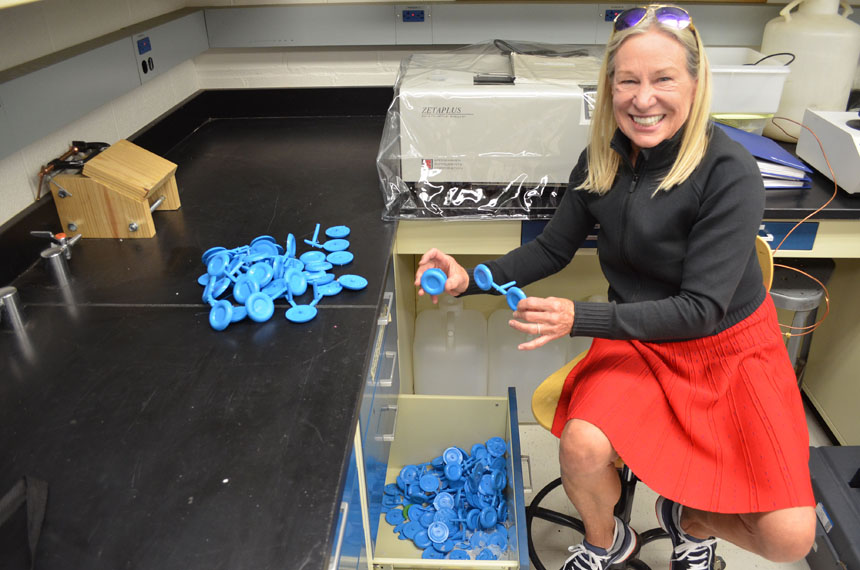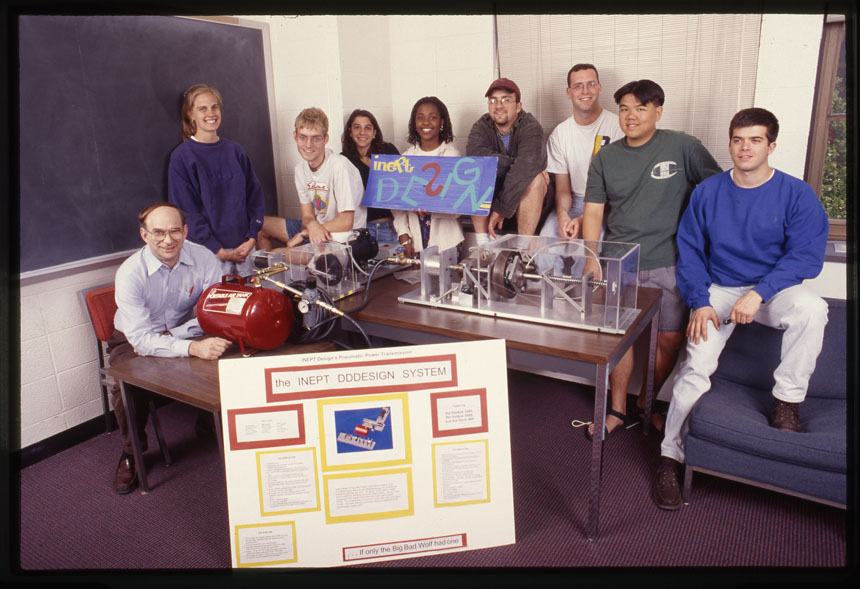An Appreciation: David Quesnel, 1952-2017
David Quesnel, at left, with students in one of his senior design teams.
“Taking Education to the Edge”
When David Quesnel taught senior design, he did it in a big way.
Instead of splitting the class into small teams of three to four students, with each team doing its own project, the professor of mechanical engineering would sometimes involve the entire class in a single, industrial scale project.
The class would even form a fictitious company so students could learn not only how to design and construct a prototype, but also gain experience in marketing, government regulations, patent issues, writing a service manual, and other “real world concerns.”
In 1997, for example, his 30 design students built a 15-foot-long injection molding system that converted chips of recycled plastic yogurt containers into yo-yos.
Two years later Quesnel’s class completed a 3,000-pound ultrasonic welding machine for a real Rochester company to make polypropylene cardholders and passport sleeves.
Another year, he split his class into three competing companies, each working independently on pneumatic power systems to replace electric motors in factories.
Quesnel believed that was the most realistic way to prepare students for the workplace – and to build their confidence.
“The magic of teaching is watching students take their education to the edge,” said Quesnel, who died recently after a lengthy illness. “Then they know they can do it.”
“It was an amazing experience,” says James Schulman ’97, who served as project manager for the yo-yo machine and now manages a design strategy team for Cigna. “And looking back, it definitely had a positive affect on my career.”
Always an Experimentalist
Quesnel relished challenges, according to the testimony of friends, family members, and colleagues at a recent memorial service in Rush Rhees Library. And it was typical of him to tackle those challenges with an “unbounded curiosity” and an ability to focus rigorously on the task at hand.
That was how Quesnel taught himself to sail on Seneca Lake and, in his 40s and 50s, to windsurf on Lake Ontario. That was how he completed numerous home remodeling projects. How he created a device—that filled a third of his garage—to pull tree roots. And how he reconstructed accidents as an expert witness.
Born in Keesville, New York, Quesnel took construction and roofing jobs during the summers to help pay his way through SUNY Stony Brook as an engineering undergraduate.
“I think this gave Dave an appreciation of physical labor” so that, even when his research delved into abstract theory, “most of his ideas tended toward practical applications,” says John Michejda, Quesnel’s roommate at SUNY Stony Brook and a lifelong friend.
Quesnel graduated magna cum laude at the top of his class. He earned his PhD in 1977 at Northwestern, where his thesis advisor was Mike Meishi, a highly regarded materials scientist. Quesnel’s thesis topic was “Low Cycle Fatigue Response of High Strength Low Alloy Steel.”
Metal fatigue—what happens, for example, when you bend a paper clip over and over until it breaks—continued to be Quesnel’s research focus when he joined the University of Rochester later that year as an assistant professor in what was then called the Department of Mechanical and Aerospace Sciences.
One practical application was a simple tool Quesnel devised with Eric Stromswold, one of his PhD students. Similar to a torque wrench, it could test how well a metal would resist the growth of a crack within it. The device sold at a mere fraction of the $50,000 price range of other testing devices then on the market, wrote Bob Reeg of the National Society of Professional Engineers.
However, in his research, as in his hobbies, Quesnel continually found new areas to explore.
“Over the years he changed his research focus significantly,” says John Lambropoulos, the chair of mechanical engineering. “But he always remained an experimentalist in materials science.”
For example, Quesnel later studied the adhesion of particles to surfaces, coauthoring a textbook on the subject.
Later still he shifted his focus to piezoelectric materials that produce voltage when squeezed. “One application involves harvesting mechanical energy that would otherwise be wasted,” Lambropoulos says. “Unfortunately piezoelectric materials break very easily because they are ceramic. A lot of the work David did was to understand how the mechanical and electrical properties of those materials could be optimized.”
And then, at a point in his career when some faculty members might start slowing down, Quesnel began to explore a topic that had always interested him: corrosion, an electrochemical reaction that may significantly compromise the strength of aluminum used for ships. He became expert in the way corrosion is exacerbated in the confined areas where two different materials come in contact, and developed a numerical model to predict corrosion under those conditions.
“For the last 15 years, his research underwent a renaissance,” Lambropoulos says. Previously, Quesnel’s research had been “comfortably” supported by the National Science Foundation and Sandia Laboratory. More recently, the Office of Naval Research became the primary funding source, awarding Quesnel grants totaling nearly $3 million between 2003 and 2012 for research involving both corrosion and piezoelectric materials.
And then, when it became apparent there were “many more jobs for my students in the area of energy storage,” Quesnel wrote, his lab again shifted focus, to exploring ways to build better batteries.
Trial by Fire
During a research career spanning four decades, Quesnel wrote or co-authored more than 120 papers, and was awarded 13 US and European patents. He advised 20 PhD students and 18 masters students. At one time or another, he taught two thirds of the department’s undergraduate courses, Lambropoulos says.
A National Science Foundation Graduate Fellow as a student, Quesnel later received a Humboldt fellowship for a year-long sabbatical at the University of Erlangen-Nuernberg. He was recipient of the Ralph R. Teetor Educational Award from the Society of Automotive Engineers, and twice received the Excellence in Undergraduate Teaching Award from the Undergrad Engineering Council in 1989 and 1991.
“David had a very industry-relevant view of education,” Lambropoulos says. “He could see that in six months or a year most of the seniors would be working in industry. His mission as a teacher was to give students as real an experience as possible.”
Which brings us back to that yo-yo machine.
At that time, the engineering curriculum was “very theoretical,” recalls Schulman. “By the time we got to senior design class, we hadn’t had a lot of chances to do hands-on, practical engineering.”
So when Quesnel told the students they would be building an injection molding machine “We all said ‘great’ and then turned to each other and asked ‘what’s an injection molding machine?’” Schulman says. “I think it was our naivete that allowed us to pull it off. If we had really thought about it, we would have had too many second thoughts.”
The students had to start from scratch. First they had to learn how to use the CAD design software that was just then coming on the scene. Quesnel arranged for the students to visit local companies to learn about different plastics. Then they spent long nights in the computer lab and the machine shop—on weekends, and even into the last week before graduation, when other students were partying and getting ready to leave.
“It was trial by fire. It’s one thing to do a theoretical exercise in class, but this was more about trying things, testing things, building prototypes,” Schulman says. And at every step, he says, Quesnel was “totally hands on and involved. Coaching us, mentoring us. Not saying ‘Do it this way,’ but helping students work through the problems in a very collaborative way. It speaks amazingly to him as professor that he trusted us and gave us this responsibility.”
“It was phenomenal,” says Lambropoulos. “Everything was machined by the students; no purchased equipment. The start of the course was early in January, and by graduation day, the machine was set up in the Hopeman (Hall) conference room and actually spitting out yo-yos.
“The funniest thing is, and I remember like it happened yesterday, the first yo-yos that came out were really misshapen,” Lambropoulos says.
But the students made last-minute adjustments, and then “we brought all the parents of all the seniors into the conference room to see it,” Lambropoulos says.
“People were lined up out of the door, down the hallway, craning their necks to get a look at it,” recalls Jill Morris, the department’s administrator. “When it started spitting out yo-yos, people went ballistic.”
Each graduating student left that day with a diploma – and a blue yo-yo as a memento.
Below, Jill Morris with some of the blue yo-yos she discovered in a drawer.


